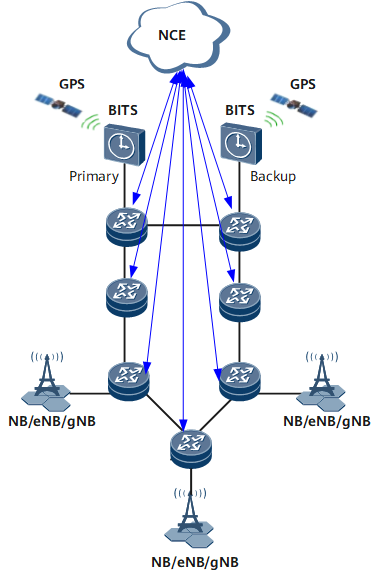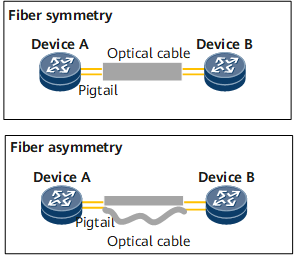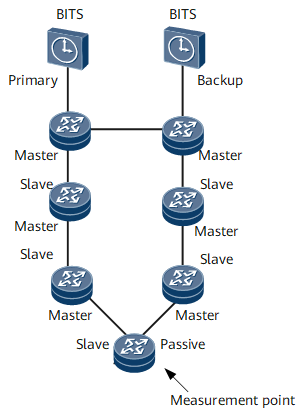Offset Measurement and Automatic Compensation
In the clock networking, the synchronization offset may exist due to the asymmetry of optical fibers. The device works with NCE to calculate the offset value, and NCE automatically delivers the offset value to the device for compensation.
Offset Introduction
The function of 1588v2 and G.8275.1 requires that the delay on the transmit and receive paths between the master and slave devices be the same. If the receive and transmit path delay values are different, a synchronization error is introduced, which is half of the receive and transmit path delay difference. In the hop-by-hop synchronization scenario, whether the delay of the receive and transmit paths between the master and slave devices is the same is determined based on the lengths of the receive and transmit fibers.
As shown in Figure 1, fiber asymmetry does not occur if the transmit and receive fibers between the master and slave devices are routed through the same optical cable and the lengths of pigtails are the same. If the transmit and receive optical fibers between the master and slave devices are routed through optical cables of different lengths or the lengths of pigtails are different, fiber asymmetry occurs.
Real-time offset Monitoring and Automatic Compensation When GPS Is Configured on the Base Station Side
As shown in Figure 2, when the GPS feature is deployed on the base station side, the device works with NCE to implement real-time offset monitoring and automatic compensation.

The service process is as follows:
- After the clock networking is complete, all devices synchronize time.
- The clock interface of each device sends the time information of the device to the base station.
- The base station calculates the offset values and sends the signaling packets back to each device, which carry offset information.
- NCE obtains the offset information received by each clock port from each device in polling mode.
- NCE determines asymmetric links and offset values on the network based on the offset information reported by each device.
- NCE delivers the offset values to the devices at both ends of the asymmetric links.
Offset Measuring Mode and Automatic Compensation of the Reference Port
If the device cannot obtain the GPS time offset information, connect the reference source (such as the BITS meter or Atom GPS) to the reference port on the device. Then, the device and NCE calculate the time offset and automatically compensate for it.
As shown in Figure 3, the service process on a ring network is as follows:
- After the passive port detection function is enabled on the entire network, the device automatically determines the device with both the slave port and passive port using the BMC algorithm.
- If the offset value on the passive port is greater than the threshold, an alarm is triggered. Otherwise, the clock network is normal and no offset is required.
- On the device where the passive port resides, select a reference port that supports 1588 synchronization and connect the reference source to the reference port.
- Each device receives the time synchronization information delivered from the reference port and calculates the offset between the restored time of the slave port and the time of the reference port.
- NCE obtains the offset information fed back by each device and determines the asymmetric links and offset values on the network.
- NCE delivers the offset values to the devices at both ends of the asymmetric links.
The service process on a chain network is as follows:
- When services are abnormal, select a reference port that supports 1588 synchronization at the end node of the chain and connect the reference source to the reference port.
- Each device receives the time synchronization information delivered from the reference port and calculates the offset between the restored time of the slave port and the time of the reference port.
- NCE obtains the offset information fed back by each device and determines the asymmetric links and offset values on the network.
- NCE delivers the offset values to the devices at both ends of the asymmetric links.

